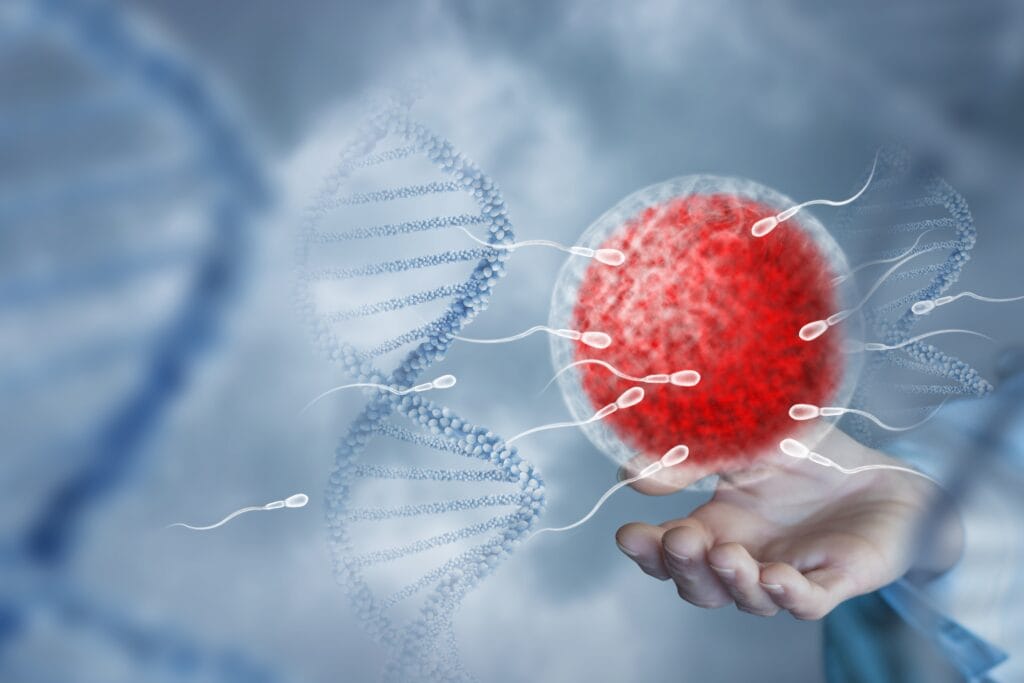Overview of Infertility
Infertility is the inability to conceive a child or carry a pregnancy to term despite regular, unprotected sexual intercourse for a certain period. It can affect both men and women and may arise from various physical, hormonal, environmental, or lifestyle-related factors. Infertility is generally classified as follows:
Types of Infertility
- Primary Infertility: A couple has never achieved a pregnancy despite trying.
- Secondary Infertility: A couple has difficulty conceiving after previously having one or more children or successful pregnancies.
Causes of Infertility

In Women
- Ovulation Disorders: Irregular or absent ovulation due to conditions like polycystic ovary syndrome (PCOS) or hormonal imbalances.
- Fallopian Tube Damage: Often caused by infections, endometriosis, or previous surgeries.
- Uterine Issues: Fibroids, polyps, or congenital abnormalities.
- Endometriosis: Tissue similar to the lining of the uterus grows outside the uterus, impacting fertility.
- Age: Fertility declines significantly after age 35.
In Men
- Low Sperm Count or Quality: Reduced sperm production or poor motility.
- Ejaculation Issues: Blockages or retrograde ejaculation.
- Hormonal Imbalances: Affecting testosterone and other reproductive hormones.
- Testicular Damage: Due to injury, infection, or environmental factors.
Other Factors
- Lifestyle Choices: Smoking, excessive alcohol use, obesity, or being underweight.
- Environmental Exposures: Pesticides, heavy metals, and radiation.
- Genetic Conditions: Inherited disorders affecting fertility.
Stress and Psychological Factors: Can impact hormone regulation.
Diagnosis and Treatment

- Diagnosis: Includes physical examinations, blood tests, ultrasound, semen analysis, and specialized fertility tests.
- Treatment Options:
- Lifestyle Changes: Diet, exercise, and stress management.
- Medications: To regulate ovulation or hormone levels.
PEMF for Infertility
PEMF therapy has been explored as a potential complementary treatment for infertility, though scientific research in this area is still emerging. Here’s an overview of how PEMF might help:
Potential Benefits of PEMF for Infertility
- Improved Circulation:
- PEMF therapy enhances blood flow and oxygenation in the body. For infertility, improved blood flow to the reproductive organs may support better ovarian function and uterine lining health, which are crucial for implantation and pregnancy.
- Reduced Inflammation:
- Chronic inflammation can negatively affect fertility. PEMF’s anti-inflammatory properties may help create a healthier environment for conception by reducing conditions like pelvic inflammatory disease or endometriosis, both of which can impair fertility.
- Hormonal Balance:
- PEMF therapy may influence the endocrine system by stimulating the hypothalamus-pituitary axis, potentially supporting hormone regulation. Hormonal balance is critical for ovulation and menstrual regularity.
- Stress Reduction:
- Stress is a significant factor in infertility. By promoting relaxation and improving sleep quality, PEMF therapy can help lower cortisol levels, supporting a better environment for conception.
- Cellular Regeneration:
- PEMF encourages cellular repair and regeneration, which might support egg quality and the overall health of the reproductive organs.

Research and Clinical Evidence
- While there are limited studies specifically linking PEMF to infertility treatments, some animal studies have shown improved fertility rates after PEMF exposure. Additionally, its established benefits for circulation, inflammation, and cellular health indirectly suggest it could support reproductive health.
How to Use PEMF for Infertility
- Targeted Application:
- Use PEMF devices with settings optimized for the pelvic region, focusing on the ovaries and uterus.
- Regular Sessions:
- Consistent use (e.g., daily or multiple times per week) over several months may yield the best results, as fertility is often influenced by long-term systemic health.
- Combination with Other Therapies:
- Pairing PEMF therapy with lifestyle changes, proper nutrition, and medical treatments can enhance its effectiveness.
Consult a Specialist
Before using PEMF for infertility, it’s essential to consult with a fertility specialist or healthcare provider to ensure it’s appropriate for your specific condition and to rule out underlying causes of infertility that may require medical intervention.
- Who Shouldn’t use PEMF
PEMF therapy is generally considered safe for most people, but there are specific situations and conditions where it may not be appropriate. Individuals who should avoid or use caution with PEMF include:
1. People with Implanted Medical Devices
- Pacemakers, Defibrillators, or Cochlear Implants: PEMF can interfere with the function of electronic implants.
- Other Medical Implants: Devices like deep brain stimulators or infusion pumps may also be affected.
2. Pregnant Women
- Although there is no conclusive evidence of harm, PEMF is generally avoided during pregnancy as a precautionary measure, especially in the early stages.
Children (Without Medical Supervision)
- Although some studies suggest PEMF may be safe for children in specific medical applications, its general use in this population requires medical guidance.
Recent Surgical Implants
- Metal implants (like joint replacements) can sometimes absorb PEMF, leading to localized heating or discomfort. Use should be evaluated on a case-by-case basis with a physician.
Positive Feedback

Fertility and Reproductive Health:
o While research is emerging, some patients with conditions like endometriosis or irregular cycles have noted improvements in symptoms.
- Stress and Anxiety Reduction:
- Infertility can be emotionally challenging, and many patients note that PEMF helps them feel calmer and more relaxed, creating a better environment for conception.
- “The therapy helped me reduce stress, which I believe played a significant role in improving my fertility journey.”
- Improved Circulation to Reproductive Organs:
- Some patients report feeling more confident about their chances of conception after learning PEMF enhances blood flow to the pelvic region.
- “I used PEMF daily to target my pelvic area, and I feel it helped prepare my body for conception.”
- Success Stories:
- A few patients attribute successful pregnancies to PEMF therapy, especially when combined with other treatments like IVF or lifestyle changes.
- “After struggling with infertility for years, I got pregnant within six months of incorporating PEMF into my routine.”
Conclusion
In conclusion, PEMF therapy shows promise as a complementary approach to addressing infertility by improving circulation, reducing inflammation, promoting hormonal balance, and alleviating stress factors that can significantly impact reproductive health. While direct research on PEMF for infertility is limited, its established benefits in enhancing overall cellular and systemic health suggest potential advantages for those struggling with fertility issues.



0 Comments